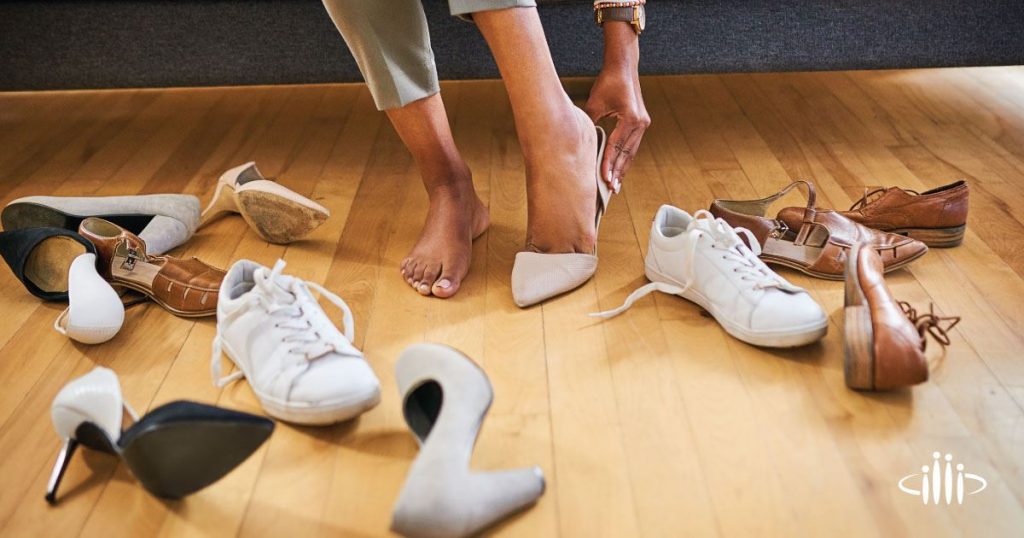
Choosing the Right Shoes
“Does fashion trump comfort when it comes to shoe choices? You may think otherwise after reading this article.”
Only a small percentage of the population is born with foot problems. Most often, it’s neglect or a lack of proper foot care—including ill-fitting shoes—that cause the problems. Since April is National Foot Health Awareness Month, what better time for Dr. Dan E. Robinson, board-certified podiatric surgeon, to share some tips about choosing the right shoes for your feet.
Shopping for shoes is best done in the afternoon. Your feet tend to swell a little during the day, and it’s best to buy shoes to fit them then. When shopping for shoes, try them on both feet; many people have one foot larger than the other, and it’s best to fit the larger one. And, when you try them on, walk in the shoes to make sure they feel right and there is no pain. (The same holds true if you buy shoes online. Follow these same steps to decide if you need to exchange shoes for the right size.)
Your foot size can change as you grow older. Have both of your feet measured every time you purchase shoes, and do it while you’re standing. Shoe sizes vary by brand and style, so don’t select shoes only by the size marked inside the shoe.
Select a shoe that conforms as closely as possible to the shape of your foot. Choose a shoe that has proper heel support. If the shoe has a flat bottom, check the inside to see if the heel is built up. A shoe that has proper support should only bend where the toes are, and should not twist like a rag.
When using a shoe insert, support is more important than cushion. Buy the most rigid insert you can find. Buy shoes that have enough space for your toes. Shoes with a pointed-toe place your toes in an unnatural position.
And, ladies, if those high heels you’ve been squeezing into now hurt, be careful. You may be stepping into more than a little pain. High heels can cause long-lasting problems in your feet, legs, and back. “Heels that are too high put a lot of pressure on the foot and body,” Dr. Robinson says. “They change the way you walk, stand, and move.”
High heels cause the ball of your foot to absorb all of your weight, which can lead to sharp pain, toe deformities, and bunions. Also, if high heels are unstable, foot and ankle sprains are more likely. Not all high heels are bad. “I suggest buying heels shorter than 2 inches, trying them on in the afternoon (again, feet swell later in the day), and avoiding those that are uncomfortable—no matter how cute they are.”
As far as buying shoes for babies, they will need their first pair of shoes once they start to walk to protect their feet from any hazards on the ground. When buying baby shoes, make sure their feet are properly measured. Be sure the soles are flexible and nonslip, have good padding, and have good closures (easy to put the shoe on, but not so easy that the shoes fall off).
Put Your Feet in Good Hands
Heel pain, foot pain, bunions, hammertoes, and other foot deformities are just some of the conditions that Dan Robinson, DPM, a board-certified foot and ankle specialist, can treat. He also helps diabetic patients control their foot pain and eliminate future problems, which sometimes leads to amputation. His patients play an active role in the treatment of their foot and ankle conditions.
If you are concerned about your feet, Dr. Robinson is always welcoming patients to his offices in Blackfoot, Pocatello, and Idaho Falls. To schedule an appointment with Dr. Robinson, contact his office at (208) 782-2490.
The content on our website is reviewed regularly and is updated when new and relevant evidence is made available. This information is neither intended nor implied to be a substitute for professional medical advice. Always seek the advice of your physician or other qualified health provider prior to starting any new treatment or with questions regarding a medical condition.
Return to Articles


